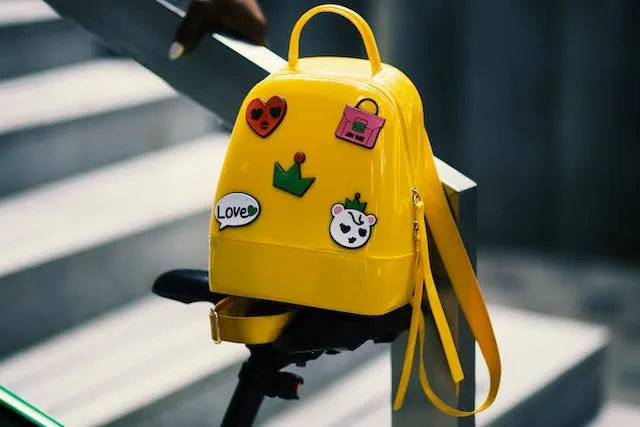How To Put Patches On Backpacks For a Stylish And Durable Result
Learning how to put patches on a backpack can enable you to transform your bags in creative or practical ways. In this guide, you will receive step-by-step instructions to modify your backpack with style and durability. Whether you seek a trendy look, some personalized flair, or a functional addition, we provide all the insight you need.
Learn about placement, attachment methods, and tips for long-lasting results to elevate your backpack game. As leading suppliers of customized patches for all kinds of apparel, we can unravel the secrets to achieve the best possible results.

Key Takeaways
- The most popular methods to put patches on backpacks are to use iron-on or sew-on patches.
- Following the proper application process is important to ensure a durable adhesion.
- Alternative methods include Velcro patches, using fabric adhesive, or pin-on patches.
- Whichever method you choose, follow best practices and avoid the common pitfalls.
- We supply high-quality custom patches with a variety of materials, styles, and attachment methods available to patch your bag.
Table of contents
How To Put Patches On A Backpack
Putting patches on backpacks is a creative endeavor, and there is more than one method available to you. Much like with putting patches on a denim jacket, the two most popular methods are iron-on patches and sew-on patches. We will look into the methods in detail in the subsequent sections, but the main difference is that iron-on patches are a quick and convenient solution, whilst sew-on patches offer a little more durability if you are prepared to do the more complicated work for attaching them.
There are various other options for how to put patches on a backpack, including:
- Velcro patches
- Adhesive patches
- Pin-on patches
- Magnetic patches
In this guide, we will walk you through the two most popular approaches and touch upon some of the alternatives. Each offers its own pros and cons, so you will need to weigh up your needs to find the right solution. We can supply customized patches in a range of materials and styles with a spectrum of attachment methods, so you are in good hands.

Attaching Iron-On Patches To Backpacks
The process to iron on a patch to a backpack is fairly straightforward, but you should be diligent in every step to achieve a secure attachment. Here is a breakdown of attaching patches to backpacks using this method:
- Select your patch: Choose or design a high-quality iron-on patch that is a good match for your backpack’s material and style.
- Prep the backpack: To iron a patch on a bag, you must ensure the backpack is clean and free of dust as it may affect the adherence.
- Position the patch: Use fabric chalk to mark the patch location. Aim for a centered, well-aligned positioning.
- Preheat the area: Before you apply the patch, warm the marked area with the iron to optimize the adhesion.
- Place the patch: Carefully position the patch on the warmed area with the adhesive side down. Place a thin cloth onto the patch to protect it from heat.
- Apply the heat: Press your iron firmly over the patch for 15-20 seconds. Move it around slowly to heat the entire patch.
- Cooling: Allow the patch and backpack to cool for a few minutes before you move it so that the adhesive can set.
- Check adherence: Gently tug at the patch edges to confirm adherence. If it lifts, reapply heat and pressure.
This is one of the best ways to put patches on a backpack, but you should be mindful of the amount of heat you apply as it could damage the backpack material. By following this process correctly, you will get an effective attachment. But be aware that regular use and washing may impact longevity.
Sewing Patches Onto Backpacks
Using sewing to put patches on a backpack requires a little more skill, but it doesn’t require you to be an expert at sewing. The following step-by-step guide should provide all you need to know:
- Choose your patch: Select a sew-on patch that complements the material and color of your backpack, or design your own with us.
- Prepare the backpack: Ensure you have a clean, smooth surface on which to sew the patch.
- Mark the bag: With fabric chalk or pin, mark out the exact location you will attach your patch.
- Get your thread and needle: Make sure you have a strong, matching thread and a suitable needle for the backpack fabric.
- Secure the patch: Start sewing from the inside of the backpack so the knots aren’t visible. Perform a few initial stitches to secure the patch.
- Stitching technique: Use a straight or zigzag stitch for a durable attachment. Keep the stitches tight and even.
- Reinforce edges: Sew around the perimeter the reinforce the patch edges, helping to prevent fraying.
- Knot the thread: Tie a secure knot on the inside of the bag once sewing is complete, trimming away any excess.
Remember that thicker backpack materials will require a stronger needle to prevent breakage during stitching. Sew-on patches are ideal to attach patches to a backpack if you need a very secure, durable attachment. The process is more time consuming than iron-on patches, but it ultimately provides a longer-lasting solution.
Can You Glue Patches On A Backpack?
It is possible to use fabric glue or another suitable adhesive to put patches on a backpack. This may not provide such a durable adhesion as iron-on or sew-on patches, but it is a quick alternative that can be quite durable with a high-quality adhesive.
The basic process looks like this:
- Ensure the backpack surface is clean.
- Apply the adhesive evenly to the back of the patch.
- Press it firmly onto the desired location on the backpack and follow instructions for drying time.
Consider the intended use and required longevity for your patches. This method could be suitable to put a patch on a bag for some.

Need removable or interchangeable patches for your backpack?
Our custom Velcro patches for backpacks are a simple solution to add and remove patches at will, and you can customize them to match your needs perfectly.
Using Velcro To Apply Patches To Backpacks
Our custom Velcro patches for backpacks are a popular choice for many seeking a versatile and interchangeable customization method. You would need the double Velcro solution, which includes the ‘loop’ backing on the reverse of the patch and a matching ‘hook’ strip to attach to your backpack with adhesive.
Attach the ‘hook’ strip on the intended location on your backpack and you have a base on which to secure any patches that have the ‘loop’ Velcro backing. This allows for the easy removal and interchanging of patches, so this is how to apply patches to backpacks if you need to regularly change what’s on display. Velcro doesn’t provide the permanence or security of sew-on or iron-on patches, but it can be a reliable option for people who need more flexibility.
Best Practices To Put Patches On Backpacks
Whether you buy generic patches, work with us to create custom ones, or make your own embroidered patches, there are some common best practices for attaching them to your backpack:
- Prepare your surface: Ensure your backpack is clean and smooth before you put a patch on your bag.
- Choose the right patch: Whether customizing or not, choose high-quality patches that complement the color, style, and material of your backpack.
- Precise placement: Aim for symmetry and alignment, and mark the patch location with fabric chalk to get the desired result.
- Adhesive or stitching: For iron-on patches, preheat the application area first, or use tight and even stitching for sew-on patches.
- Reinforcement: Check the patch edges once you have put your patches on the backpack. This will help prevent fraying.
- Final inspection: Make sure you double-check for even placement and a secure attachment before you consider the job done.
Follow these tips to attach a patch to a backpack securely.
Add a name to your backpack with a vibrant, personalized design
Work with us to create custom name patches for backpacks so your baggage can be easily identified no matter where you are.
Create your custom designBenefits Of Putting A Patch On A Bag
There can be numerous aesthetic and practical benefits to applying patches to backpacks. When you work with us to create custom patches, you can use them for brand representation or to express an element of your personality. These patches are a canvas for conveying something or communicating a message, and you can put a patch on a bag to transform it into a statement piece.
Patches can enhance your backpack’s visual appeal as well, modifying a plain item to be an eye-catching accessory. Or you can strategically place your patches to mend worn areas, thus enhancing the bag’s lifespan.
Finally, for outdoors groups or camping expeditions, you can create custom name patches for backpacks to identify your gear. This is a purely practical application for attaching patches to a backpack, but it can also be combined with branding to showcase your affiliation with the group. Overall, there can be many benefits of putting a patch on a bag.
Creative Ideas For How To Put Patches On A Backpack
Unleash your creativity when designing and applying custom patches for backpacks. Your personalized designs, and the way you put patches on your backpack, can allow your creativity to shine through. Here are some ideas to consider:
- Storyboard collage: Arrange patches to tell a visual story, with each patch representing a unique chapter in your journey with the backpack.
- Geometric patterns: Strategically place your patches to create bold geometric shapes of patterns on your backpack.
- Nature inspiration: Create a collage of nature-themed patches to combine images of flowers, animals, or landscapes.
- Quirky characters: Design patches with playful patches or mascots and arrange them on the backpack for a playful, whimsical aesthetic.
- Monograms: Arrange patches to form your initials or a monogram for a personalized touch.
- Color palette: Design your patches to match a specific color palette to create a cohesive, harmonious visual aesthetic.
These ideas are intended to provide inspiration for how to put patches on a backpack. Use them to devise your own creations and cultivate a personalized masterpiece.

Want the freedom to design your own backpack patches?
With our custom patches for backpacks, you choose the custom design and select a material, size, attachment method, and other features to embellish your backpack.
Common Mistakes When Attaching Patches To Backpacks
Avoid these common mistakes when you add patches to a backpack to avoid having to remove your patches and reapply them:
- Failing to clean the backpack beforehand, thus hindering the effectiveness of your attachment method.
- Incorrectly positioning the patch, resulting in an uneven or unbalanced appearance.
- Choosing the wrong adhesive, or the wrong heat settings for iron-on patches, resulting in a weak adhesion.
- Using the wrong needle and thread, leading to broken needles, unmatched colors, or compromised durability.
- Skipping the reinforcement step, meaning the patch has loose edges that could become frayed.
- Failing to mark or pin the backpack, resulting in misalignment with your patch placement.
- Hasty stitching, leading to uneven seams and other stitching issues.
Be mindful of these pitfalls when you put patches on backpacks. Cutting corners is never helpful, and it’s important to get the best possible outcome.
Frequently Asked Questions About How To Put Patches On A Backpack
Do Iron-On Patches Attach To Backpacks Well?
Yes they do, as long as you follow the correct process to attach them. Mistakes like not cleaning the backpack first or using the wrong heat setting can compromise the attachment durability.
How Do You Put Patches On A Backpack Without Sewing?
If you don’t want to sew to put patches on a backpack, popular alternatives include using iron-on or Velcro patches, or gluing with fabric adhesive. All have their own pros and cons.
What Is The Best Way To Attach Patches To Backpacks?
Sewing creates the strongest, most permanent attachment, but iron-on patches are good and simpler to apply. Velcro patches offer the most flexibility, so decide what your needs are.